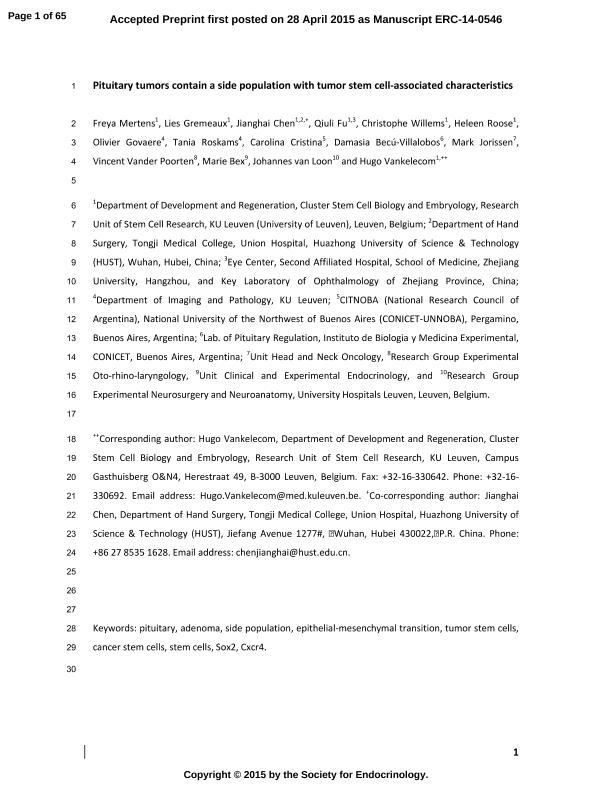Artículo
Pituitary tumors contain a side population with tumor stem cell-associated characteristics
Mertens, Freya; Gremeaux, Lies; Chen, Jianghai; Fu, Qiuli; Willems, Christophe; Roose, Heleen; Govaere, Olivier; Roskams, Tania; Cristina, Silvia Carolina ; Becu Villalobos, Damasia
; Becu Villalobos, Damasia ; Joriseen, Mark; Vander Poorten, Vincent; Bex, Marie; Van Loon, Johannes; Vankelecom, Hugo
; Joriseen, Mark; Vander Poorten, Vincent; Bex, Marie; Van Loon, Johannes; Vankelecom, Hugo
 ; Becu Villalobos, Damasia
; Becu Villalobos, Damasia ; Joriseen, Mark; Vander Poorten, Vincent; Bex, Marie; Van Loon, Johannes; Vankelecom, Hugo
; Joriseen, Mark; Vander Poorten, Vincent; Bex, Marie; Van Loon, Johannes; Vankelecom, Hugo
Fecha de publicación:
25/04/2015
Editorial:
Bioscientifica
Revista:
Endocrine - Related Cancer
ISSN:
1351-0088
e-ISSN:
1479-6821
Idioma:
Inglés
Tipo de recurso:
Artículo publicado
Clasificación temática:
Resumen
Pituitary adenomas cause significant endocrine and mass-related morbidity. Little is known about the mechanisms that underlie pituitary tumor pathogenesis. In the present study, we searched for a side population (SP) in pituitary tumors representing cells with high efflux capacity and potentially enriched for tumor stem cells (TSCs). Human pituitary adenomas contain a SP irrespective of hormonal phenotype. This adenoma SP, as well as the purified SP (pSP) that is depleted from endothelial and immune cells, is enriched for cells that express ‘tumor stemness’ markers and signaling pathways, including epithelial–mesenchymal transition (EMT)-linked factors. Pituitary adenomas were found to contain self-renewing sphere-forming cells, considered to be a property of TSCs. These sphere-initiating cells were recovered in the pSP. Because benign pituitary adenomas do not grow in vitro and have failed to expand in immunodeficient mice, the pituitary tumor cell line AtT20 was further used. We identified a SP in this cell line and found it to be more tumorigenic than the non-SP ‘main population’. Of the two EMT regulatory pathways tested, the inhibition of chemokine (C-X-C motif) receptor 4 (CXCR4) signaling reduced EMT-associated cell motility in vitro as well as xenograft tumor growth, whereas the activation of TGFβ had no effect. The human adenoma pSP also showed upregulated expression of the pituitary stem cell marker SOX2. Pituitaries from dopamine receptor D2 knockout (Drd2−/−) mice that bear prolactinomas contain more pSP, Sox2+, and colony-forming cells than WT glands. In conclusion, we detected a SP in pituitary tumors and identified TSC-associated characteristics. The present study adds new elements to the unraveling of pituitary tumor pathogenesis and may lead to the identification of new therapeutic targets.
Palabras clave:
Pituitary
,
Stem Cells
,
Adenoma
,
Microarray
,
Cancer Stem Cell
Archivos asociados
Licencia
Identificadores
Colecciones
Articulos(IBYME)
Articulos de INST.DE BIOLOGIA Y MEDICINA EXPERIMENTAL (I)
Articulos de INST.DE BIOLOGIA Y MEDICINA EXPERIMENTAL (I)
Articulos(SEDE CENTRAL)
Articulos de SEDE CENTRAL
Articulos de SEDE CENTRAL
Citación
Mertens, Freya; Gremeaux, Lies; Chen, Jianghai; Fu, Qiuli; Willems, Christophe; et al.; Pituitary tumors contain a side population with tumor stem cell-associated characteristics; Bioscientifica; Endocrine - Related Cancer; 22; 4; 25-4-2015; 481-504
Compartir
Altmétricas



